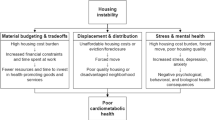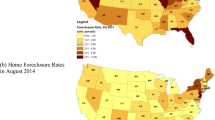Abstract
Housing instability, a growing public health problem, may be an independent environmental risk factor for hypertension, but limited prospective data exist. We sought to determine the independent association of housing instability in early adulthood (year 5, 1990–1991) and incident hypertension over the subsequent 15 years of follow-up (years 7, 10, 15, and 20) in the Coronary Artery Risk Development in Young Adults (CARDIA) study (N = 5,115). Because causes of inadequate housing and its effects on health are thought to vary by race and sex, we hypothesized that housing instability would exert a differential effect on incident hypertension by race and sex. At year 5, all CARDIA participants were asked about housing and those free of hypertension were analyzed (N = 4,342). We defined housing instability as living in overcrowded housing, moving frequently, or living doubled up. Of the 4,342 participants, 8.5 % were living in unstable housing. Across all participants, housing instability was not associated with incident hypertension (incidence rate ratio (IRR), 1.1; 95 % CI, 0.9–1.5) after adjusting for demographics, socioeconomic status, substance use, social factors, body mass index, and study site. However, the association varied by race and sex (p value for interaction, <0.001). Unstably housed white women had a hypertension incidence rate 4.7 times (IRR, 4.7; 95 % CI, 2.4–9.2) that of stably housed white women in adjusted analysis. There was no association among white men, black women, or black men. These findings suggest that housing instability may be a more important risk factor among white women, and may act independently or as a marker for other psychosocial stressors (e.g., stress from intimate partner violence) leading to development of hypertension. Studies that examine the role of these psychosocial stressors in development of hypertension risk among unstably housed white women are needed.

Similar content being viewed by others
References
Kushel MB, Gupta R, Gee L, Haas JS. Housing instability and food insecurity as barriers to health care among low-income Americans. J Gen Intern Med. 2006; 21(1): 71–77.
Bassuk EL, Weinreb LF, Buckner JC, Browne A, Salomon A, Bassuk SS. The characteristics and needs of sheltered homeless and low-income housed mothers. JAMA. 1996; 276(8): 640–646.
Appleby L, Desai P. Residential instability: a perspective on system imbalance. Am J Orthopsychiatry. 1987; 57(4): 515–524.
Rossi PH, Wright JD, Fisher GA, Willis G. The urban homeless: estimating composition and size. Science. 1987; 235(4794): 1336–1341.
Lawson SB. Housing instability: toward a better understanding of frequent residential mobility among America's urban poor. Washington, DC: Center for Housing Policy; 2010.
Cutts DB, Meyers AF, Black MM, et al. US Housing insecurity and the health of very young children. Am J Public Health. 2011; 101(8): 1508–1514.
Homelessness Research Institute. State of homelessness in America 2011. Washington, DC. Available at: http://www.endhomelessness.org/content/article/detail/3668. Accessed July 14, 2011.
Eckholm E. “Recession raises poverty rates to 15-year high”. New York Times, September 17, 2010 late ed.: A1. Print.
Homelessness Research Institute. Economic Bytes: Double up in the United States, 2010. Washington, DC. Available at: http://www.endhomelessness.org/content/article/detail/3024. Accessed July 14, 2011.
DeNavas-Walt C, Procter BD, Smith JC. Income, Poverty, and Health Insurance Coverage in the United States: 2009. Washington, DC: U.S. Census Bureau, Current Population Reports, P60–238; 2010.
The 2009 Annual Homeless Assessment Report to Congress. Washington, DC: U.S. Department of Housing and Urban Development, Office of Community Planning and Development; 2010.
Koegel P, Melamid E, Burnam A. Childhood risk factors for homelessness among homeless adults. Am J Public Health. 1995; 85(12): 1642–1649.
Stein JA, Andersen R, Gelberg L. Applying the Gelberg–Andersen behavioral model for vulnerable populations to health services utilization in homeless women. J Health Psychol. 2007; 12(5): 791–804.
Kushel MB, Vittinghoff E, Haas JS. Factors associated with the health care utilization of homeless persons. JAMA. 2001; 285(2): 200–206.
Baggett TP, O'Connell JJ, Singer DE, Rigotti NA. The unmet health care needs of homeless adults: a national study. Am J Public Health. 2010; 100(7): 1326–1333.
Gelberg L, Linn LS, Usatine RP, Smith MH. Health, homelessness, and poverty. A study of clinic users. Arch Intern Med. 1990; 150(11): 2325–2330.
Hwang SW. Homelessness and health. CMAJ. 2001; 164(2): 229–233.
Szerlip MI, Szerlip HM. Identification of cardiovascular risk factors in homeless adults. Am J Med Sci. 2002; 324(5): 243–246.
Hwang SW, Wilkins R, Tjepkema M, O'Campo PJ, Dunn JR. Mortality among residents of shelters, rooming houses, and hotels in Canada: 11 year follow-up study. BMJ. 2009; 339: b4036.
Hwang SW, Orav EJ, O'Connell JJ, Lebow JM, Brennan TA. Causes of death in homeless adults in Boston. Ann Intern Med. 1997; 126(8): 625–628.
Ma CT, Gee L, Kushel MB. Associations between housing instability and food insecurity with health care access in low-income children. Ambul Pediatr. 2008; 8(1): 50–57.
Diez-Roux AV, Northridge ME, Morabia A, Bassett MT, Shea S. Prevalence and social correlates of cardiovascular disease risk factors in Harlem. Am J Public Health. 1999; 89(3): 302–307.
Matthews KA, Kiefe CI, Lewis CE, Liu K, Sidney S, Yunis C. Socioeconomic trajectories and incident hypertension in a biracial cohort of young adults. Hypertension. 2002; 39(3): 772–776.
Diez Roux AV. Residential environments and cardiovascular risk. J Urban Health. 2003; 80(4): 569–589.
Mujahid MS, Diez Roux AV, Morenoff JD, et al. Neighborhood characteristics and hypertension. Epidemiology. 2008; 19(4): 590–598.
Gelberg L, Linn LS. Assessing the physical health of homeless adults. JAMA. 1989; 262(14): 1973–1979.
Levenstein S, Smith MW, Kaplan GA. Psychosocial predictors of hypertension in men and women. Arch Intern Med. 2001; 161(10): 1341–1346.
Schoenthaler AM, Schwartz J, Cassells A, Tobin JN, Brondolo E. Daily interpersonal conflict predicts masked hypertension in an urban sample. Am J Hypertens. 2010; 23: 1982–1088.
Wang EA, Pletcher M, Lin F, et al. Incarceration, incident hypertension, and access to health care: findings from the coronary artery risk development in young adults (CARDIA) study. Arch Intern Med. 2009; 169(7): 687–693.
Krieger N, Sidney S. Racial discrimination and blood pressure: the CARDIA study of young black and white adults. Am J Public Health. 1996; 86(10): 1370–1378.
Hughes GH, Cutter G, Donahue R, et al. Recruitment in the coronary artery disease risk development in young adults (CARDIA) study. Control Clin Trials. 1987; 8(4 Suppl): 68S–73S.
Friedman GD, Cutter GR, Donahue RP, et al. CARDIA: study design, recruitment, and some characteristics of the examined subjects. J Clin Epidemiol. 1988; 41(11): 1105–1116.
Blake KS, Kellerson LR, and Simic A. Measuring overcrowding in housing. Washington, DC: US Department of Housing and Urban Development, Office of Policy Development and Research; 2007.
U.S. Department of Health and Human Services. Prior HHS Poverty Guidelines and Federal Register References.Washington, DC. Available at: http://aspe.hhs.gov/poverty/figures-fed-reg.shtml. Accessed July 14, 2011.
Pletcher MJ, Varosy P, Kiefe CI, Lewis CE, Sidney S, Hulley SB. Alcohol consumption, binge drinking, and early coronary calcification: findings from the Coronary Artery Risk Development in Young Adults (CARDIA) Study. Am J Epidemiol. 2005; 161(5): 423–433.
National Institute on Alcohol Abuse and Alcoholism. Hel** patients who drink too much: a clinicians’ guide, 2005. Washington, DC. Available at: http://pubs.niaaa.nih.gov/publications/Practitioner/CliniciansGuide2005/guide.pdf. Accessed July 14, 2011.
Davidson K, Jonas BS, Dixon KE, Markovitz JH. Do depression symptoms predict early hypertension incidence in young adults in the CARDIA study? Coronary artery risk development in young adults. Arch Intern Med. 2000; 160(10): 1495–1500.
Radloff L. The CES-D Scale: a self-report depression scale for research in the general population. Appl Psychol Measure. 1977; 1: 385–401.
Weissman MM, Sholomskas D, Pottenger M, Prusoff BA, Locke BZ. Assessing depressive symptoms in five psychiatric populations: a validation study. Am J Epidemiol. 1977; 106(3): 203–214.
Hajjar I, Kotchen JM, Kotchen TA. Hypertension: trends in prevalence, incidence, and control. Annu Rev Public Health. 2006; 27: 465–490.
Kramer H, Han C, Post W, et al. Racial/ethnic differences in hypertension and hypertension treatment and control in the multi-ethnic study of atherosclerosis (MESA). Am J Hypertens. 2004; 17(10): 963–970.
Diez Roux AV, Chambless L, Merkin SS, et al. Socioeconomic disadvantage and change in blood pressure associated with aging. Circulation. 2002; 106(6): 703–710.
Hajjar I, Kotchen TA. Trends in prevalence, awareness, treatment, and control of hypertension in the United States, 1988–2000. JAMA. 2003; 290(2): 199–206.
Austin EL, Andersen R, Gelberg L. Ethnic differences in the correlates of mental distress among homeless women. Womens Health Issues. 2008; 18(1): 26–34.
Teruya C, Longshore D, Andersen RM, et al. Health and health care disparities among homeless women. Women Health. 2010; 50(8): 719–736.
Gelberg L, Andersen R, Longshore D, et al. Hospitalizations among homeless women: are there ethnic and drug abuse disparities? J Behav Health Serv Res. 2009; 36(2): 212–232.
Riley EH, Wright RJ, Jun HJ, Hibert EN, Rich-Edwards JW. Hypertension in adult survivors of child abuse: observations from the Nurses' Health Study II. J Epidemiol Community Health. 2010; 64(5): 413–418.
Scott-Storey K, Wuest J, Ford-Gilboe M. Intimate partner violence and cardiovascular risk: is there a link? J Adv Nurs. 2009; 65(10): 2186–2197.
Cloutier S, Martin SL, Poole C. Sexual assault among North Carolina women: prevalence and health risk factors. J Epidemiol Community Health. 2002; 56(4): 265–271.
Danese A, Moffitt TE, Harrington H, et al. Adverse childhood experiences and adult risk factors for age-related disease: depression, inflammation, and clustering of metabolic risk markers. Arch Pediatr Adolesc Med. 2009; 163(12): 1135–1143.
Nabi H, Chastang JF, Lefevre T, et al. Trajectories of depressive episodes and hypertension over 24 years: the Whitehall II prospective cohort study. Hypertens. 2011; 57(4): 710–716.
Anderson NB, Myers HF, Pickering T, Jackson JS. Hypertension in blacks: psychosocial and biological perspectives. J Hypertens. 1989; 7(3): 161–172.
Williams DR. Black–white differences in blood pressure: the role of social factors. Ethn Dis. 1992; 2(2): 126–141.
Acknowledgments
Dr. Vijayaraghavan was supported by the Department of Health and Human Services-Health Resources and Services Administration, Primary Care Research Fellowship grant (D55HP05165) at the University of California, San Francisco. Dr. Vijayaraghavan is currently supported by a post-doctoral fellowship at the Cancer Prevention and Control Program, Moores Cancer Center at the University of California, San Diego. Dr. Bibbins-Domingo was supported by grants from the Robert Wood Johnson Amos Faculty Development Program, a diversity supplement to the CARDIA study contract to the University of Alabama Coordinating Center (grant N01-HC-95095), and by a UCSF Hellman Family Faculty Award. Preliminary results from this study were presented at the UCSF Health Disparities Research Symposium, 22 October 2010, and the Annual Society of General Internal Medicine Conference, 4–7 May 2011. The authors would like to thank Tekeshe Mekonnen, MS, for providing administrative assistance in the submission of the manuscript.
Financial Sources
Work on this manuscript was supported (or partially supported) by contracts: University of Alabama at Birmingham, Coordinating Center, N01-HC-95095; University of Alabama at Birmingham, Field Center, N01-HC-48047; University of Minnesota, Field Center and Diet Reading Center (Year 20 Exam), N01-HC-48048; Northwestern University, Field Center, N01-HC-48049; Kaiser Foundation Research Institute, N01-HC-48050; University of California, Irvine, Echocardiography Reading Center (Year 5 and 10), N01-HC-45134; Harbor-UCLA Research Education Institute, Computed Tomography Reading Center (Year 15 Exam), N01-HC-05187; Wake Forest University (Year 20 Exam), N01-HC-45205; New England Medical Center (Year 20 Exam), N01-HC-45204 from the National Heart, Lung and Blood Institute. The funding organizations had no role in the design and conduct of the study.
Author information
Authors and Affiliations
Corresponding author
Rights and permissions
About this article
Cite this article
Vijayaraghavan, M., Kushel, M.B., Vittinghoff, E. et al. Housing Instability and Incident Hypertension in the CARDIA Cohort. J Urban Health 90, 427–441 (2013). https://doi.org/10.1007/s11524-012-9729-z
Published:
Issue Date:
DOI: https://doi.org/10.1007/s11524-012-9729-z




